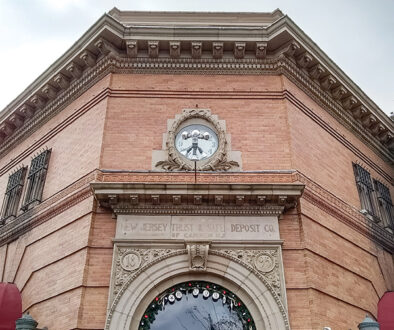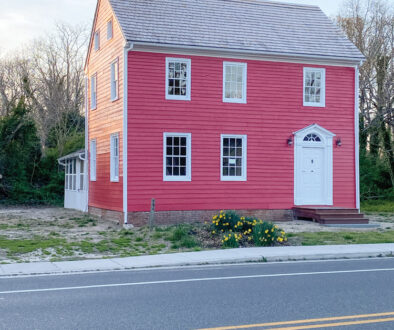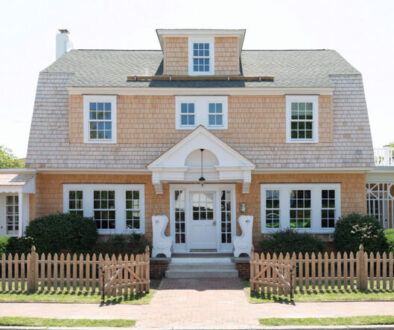The Philadelphia Physick House

The Physick House is one of the most popular places in Cape May. But did you know it has a sibling in Philadelphia?
The Philadelphia Hill-Physick House, like Cape May’s, is a well-furnished period museum with a garden, and open to the public for tours of its exceptional architecture and fascinating family history.
Cape May’s Physick House is a Victorian museum, built in 1879 as a country home by the sea for Dr. Emlen Physick Jr., his mother, and her two maiden sisters. Emlen Physick never practiced medicine, though his grandfather, Dr. Philip Syng Physick, was a famous physician who was internationally known as “the father of American surgery.”
The Hill-Physick House is a three-story brick with Federal styling, featuring a double front door topped by an arch fanlight, which was imported from London when the home was constructed in 1786. Henry Hill described his home as the “plainest state of elegance in London fashion,” when it was built as a stand-alone mansion in a row house neighborhood. Hill was a Revolutionary War Colonel who became rich outsmarting the British and its tariffs by importing Madeira, the favored wine of the founding fathers.
Dr. Philip Syng Physick (1768–1837) inherited the house from his sister Abigail in 1815. Among the most interesting exhibits are Dr. Physick’s surgical tools on the second floor, which include bloodletting instruments, stomach pumps, clamps, and tubes used to remove kidney stones. Dr. Physick designed a number of tools: needle forceps, the guillotine/snare for tonsillectomies, and splints and traction devices for skeletal dislocations.
A guide explains that Philip was a reluctant physician. He wanted to become a silversmith like his grandfather Philip Syng (1703–1789), who was Ben Franklin’s good friend and fellow innovator. Syng designed the inkstand in which the founding fathers dipped their quills to sign the Declaration of Independence and the Constitution.
Philip’s father, a strict Quaker and overseer of William Penn’s properties, forced his son into medical school. The young student became so upset working with cadavers that he begged to drop out. He felt he did not have the stamina or aptitude to become a physician. His father prevailed, sending him to London to the John Hunter School for aspiring surgeons. “What textbooks would be required?” the father asked. He was ushered into the cadaver room by Dr. Hunter, who pointed to a line of bodies and said, “These are the only textbooks, sir.” Under Dr. Hunter’s guidance, young Physick conquered his anxieties, became expert in anatomy, and the top student in his class.
He graduated from London’s Royal College of Surgeons, received his medical doctorate from the University of Edinburgh, and returned to Philadelphia in 1792. In an effort to build his practice, he offered the first health insurance package in America, advertising that for $20 he would care for an entire family for a year.
The next year, in 1793, yellow fever swept through Philadelphia, then a city of 50,000. The epidemic had arrived at the docks, imported from a Caribbean ship. Deaths reached a peak in late summer. In less than two months 5,000 died, while thousands of others fled the city. Dr. Physick stayed to care for the sick, and became stricken himself. Doctors did not know mosquitoes were the carriers, and disagreed on a treatment for the virus. One of the most popular was bleeding and purging, which Dr. Physick endured and survived at the hand of his colleague, Dr. Benjamin Rush. He credited Rush with saving his life. Physick, too, used the bleeding technique, but surgery was rapidly taking over his practice as he was gaining the reputation of being the best in Philadelphia.
Dr. Physick’s personal life had suffered in his devotion to medicine. In 1800 he married Elizabeth Emlen, the socially prominent and wealthy daughter of a Quaker preacher. They had seven children, four of whom survived. Their unhappy marriage became the subject of gossip and ultimately, scandal. Dr. Physick left his wife after 15 years of marriage. Their fights were legendary, the last said to be over a tree in the backyard. Dr. Physick legally separated from his wife and moved with his children into the 32- room mansion at 321 South Fourth Street he inherited from his sister. He forbid his wife from ever stepping foot on the property. Such action was unprecedented in proper Quaker households.
Dr. Physick renovated the house to provide for medical facilities. Among his VIP patients were Dolley Madison, the daughters of Presidents John Adams and James Monroe, and President Andrew Jackson, who consulted him about lung hemorrhages. Physick told Jackson to stop smoking and to quit taking medicines containing mercury and arsenic. When Chief Justice John Marshall was stricken with gall bladder stones, he chose Physick to remove them (and they currently reside at Philadelphia’s Mütter Museum). Dr. Physick lived at the house from 1815 to 1837 while becoming world famous as a surgeon. He performed the first successful human blood transfusion, introduced cataract surgery, developed artery aneurism repair, and the treatment of skull fractures. He routinely used autopsy as a means of discovery and diagnosis, was the first professor of surgery at the University of Pennsylvania, and taught for 30 years at Penn and Pennsylvania Hospital. Dr. Physick was not, however, interested in publishing his techniques. It was his nephew who authored a consolidation of his lectures and case studies in the 1813 book Elements of Surgery.
After Dr. Physick’s death in 1837, the house remained in the family for the next 58 years. A change in ownership brought on a variety of uses. It was a hospitality center for servicemen during World War II. There are tales of soldiers playing basketball in the grand ballroom. It was a dance studio and a rental home. Eventually it was abandoned and subsequently vandalized.
In the late 1960s, Philadelphia Inquirer publisher Walter Annenberg became its savior. Made aware of its important history and architecture, he bought the property from the Redevelopment Authority. It was targeted for bulldozing to make way for a gas station for the many new homeowners in Society Hill, the historic neighborhood around Independence Hall that had been undergoing a restoration renaissance. Annenberg and his wife Leonore rehabilitated the home and began refurnishing it with Federal and Empire period pieces. Woodwork needed to be replaced. Longtime former owner Mrs. Charles Penrose Keith had a phobia against dust, and had stripped most of the original Federal woodwork: interior shutters, baseboards, door surrounds, and stair balusters. The Annenbergs donated the house to the Philadelphia Society for the Preservation of Landmarks, and the property was designated a National Historic Landmark in 1976. As the house was being defined as a museum, Physick and Syng descendants contributed family heirlooms.
Then in 2004, 167 years after Dr. Physick’s death, a live branch of the family tree emerged to live in the house. J. Del Conner, a great-great-great grandson, moved in and was supervising caretaker for 12 years. Conner, born in Germantown, learned when he was a boy from his father about his famous Colonial ancestors.
“My childhood interest in my roots grew to being involved with the Physick House. I was on the property committee for 10 or so years,” says Conner, while living at another historic site, Awbury Arboretum in Germantown. “I spent 20 years at the Arboretum working on the grounds, now 55 acres, and restoring the 1852 Henry Cope House, a very large, 9,000 square foot structure, one of several that were part of the original Quaker family enclave that is Awbury.” Conner sold the house in 2004 while going through a divorce, and chose to experience life in the Hill-Physick House. He claims the house is haunted by his great-great-great grandmother Elizabeth, who was forbidden to set foot on the steps. It is there, on the steps, he says, that she appears, knocks on the door and flees.

While caretaker, Conner decided to honor another of his famous ancestor’s firsts—carbonated water or “soda pop” for the relief of gastric distress. “Dr. Physick offered the delivery of soda water doses for $1.50 a month,” says Conner. “For flavor, he mixed in some cherry shrub.” When the 200th anniversary of the invention rolled around in 2007, Conner was prepared with his own version: Dr. Physick—America’s First Soda, Black Cherry—Introduced in 1807. He hosted a big birthday bash—among other festivities—introducing the soda. He later went into the business of producing the soda, which retails for $13 for a four-pack of 12-ounce bottles at historic gift shops, including at the Physick Estate in Cape May.
“As a graphic artist and sculptor,” says Conner, “I have always related most to my great-great-great-great-great grandfather, Philip Syng, the silversmith, who among his designs, created with Benjamin Franklin the seal for the first fire company.”
Conner designs hand-illustrated aerial view dimensional maps of Philadelphia neighborhoods and universities called Bird’s Eye View Maps. His most popular art form is producing Pennsylvania Firebacks. In the 1970s he realized there was a market for the all-but-forgotten fireplace appliance, the cast iron fireback. “In earlier times,” he says, “the well-appointed fireplace was never complete without a fireback to protect the masonry and reflect the heat forward.”
The twists and turns of Conner’s family tree and Cape May connections compose a fascinating narrative. His five time great-grandfather, Philip Syng, the silversmith and a widower, found his way from Philadelphia to Cape May after retirement, and in 1724, married Mayflower descendant Hannah Whilden, widow of Thomas Leaming.
Conner’s great-great grandmother Susan Physick, who grew up at the Hill-Physick House in Philadelphia, married Commodore David Conner. They traveled from Philadelphia to vacation in Cape May in its early resort days. Commodore Conner emerged a hero from the 1812 and Mexican-American wars. Colonel Conner’s portrait hangs in the Hill-Physick House along with his sword for gallantry, battle medals, and other artifacts.
He was honored May 6, 1847 at a grand dinner celebration at Cape May’s Columbia House Hotel. “The bill of fare is amazing, overwhelming,” says Del Conner, who has the menu among his memorabilia. There is a soup course, followed by fish. Then a second course offering fish, ham, turkey, chicken, beef or mutton, followed by a choice of cold dishes, plus 16 side dishes, a third course of beef, lamb, turkey, chicken, pig, duck, ham and veal, plus three kinds of pie and custards, and jellies, ice creams, fresh and dried fruit and nuts.
Del Conner says that he was aware of both ancestral Physick Houses, in Philadelphia and Cape May, from the time he was a youngster. His family vacationed at the shore, and his father took him for visits to Cape May’s Physick House to learn about his eccentric relative, Dr. Emlen Physick Jr. He walked the streets of Society Hill with his father, soaking up tales of the life and times of his famous Philadelphia great-grandfathers Philip Syng, who designed for the founding fathers, and Dr. Philip Syng Physick, the father of American surgery. Conner says that it is a humbling honor to be a descendant, to walk the rooms of the two Physick Houses, and to bring alive in conversations the people in the portraits.
“I don’t have the words to express rightly how it feels, but it is a gift, and I am grateful.”



